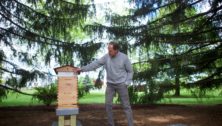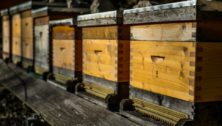Media Borough Takes on Active Role to Protect Native Bees

Welcome to Bee City, USA, known to the locals as Media Borough.
The county seat is now an official Bee City, writes Kenny Cooper for WHYY.
On June 2, it joined forces with 300 towns, cities and college campuses to protect native bee species through the Bee City USA initiative.
The initiative comes from the Xerces Society for Invertebrate Conservation.
There are more than 3,600 native bee species in the U.S., but the number is rapidly declining. Nearly 40% of pollinator species worldwide are facing extinction.
Habitat loss, pesticides, and the climate crisis are to blame.
Media must create a pollinator habitat and adopt an integrated pest management plan to reduce pesticide use on municipal property. It must also conduct pollinator conservation outreach.
“Even a small bit of habitat can really make a difference for bees, and especially in urban areas, habitat may really be at a premium,” said Laura Rost, a Bee City and Bee Campus coordinator.
Media got involved through the advocacy of Linda Coulston, of Transition Town Media and its Protecting Biodiversity subgroup. They are trying to reduce the borough’s carbon footprint through community efforts.
Read more at WHYY about Media Borough’s Bee City designation.
Here’s an interview with Phyllis Stiles, the founder of Bee City, USA.
Join Our Community
Never miss a Delaware County story!
"*" indicates required fields



























![95000-1023_ACJ_BannerAd[1]](https://delco.today/wp-content/uploads/sites/3/2023/03/95000-1023_ACJ_BannerAd1.jpg)



